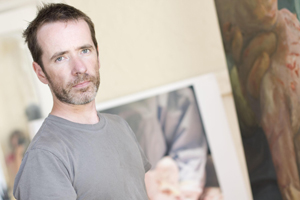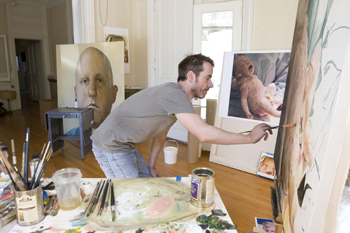 |
Mark Gilbert |
The exhibit, titled “Here I Am and Nowhere Else: Portraits of Care,” will feature dozens of portraits done by Mark Gilbert, a Scottish artist who worked at UNMC for the past two years as an artist-in-residence.
The project was formulated by William Lydiatt, M.D., professor in the otolaryngology-head and neck surgery department, and Virginia Aita, Ph.D., associate professor in the College of Public Health.
Drs. Lydiatt and Aita first met Gilbert when they brought his “Saving Faces” art exhibit to Omaha in 2006. The exhibit featured before and after portraits of patients who underwent head and neck surgery.
During his time at UNMC, Gilbert drew portraits of many different patients and their caregivers. The patients, who included children and adults, were dealing with a variety of health promotion and illness situations from childbirth to medical conditions such as AIDS, head and neck cancer or some sort of organ transplant. Most of the collection will be on display at the Bemis Center for Contemporary Arts through Feb. 21.
|
Following Gilbert’s creation of the portraits, Drs. Aita and Lydiatt collected responses from the subjects regarding their portraits. The responses found that for many individuals the project had a “transcendent effect,” Dr. Lydiatt said.
“We heard from many of the subjects that Mark’s portrait allowed them to better know themselves than they did before,” he said. “Ultimately, this is all about how art can be used to enhance people’s understanding of health, illness and caregiving.”
Hesse McGraw, curator at the Bemis Center, said: “The project asks many pointed questions: Could this community of portraits affect the relationship between patients and caregivers? Might they create a new model for medical research? How will this affect the potential for art to integrate with medicine and can it possibly alter public perceptions of illness? Will the portraits alter their subjects’ understanding of themselves? How will the public respond to the portraits?”
Drs. Lydiatt and Aita will attempt to come up with answers to these various questions by compiling data gleaned from the patients and caregivers as well as from surveys completed by people coming through the art exhibit. They hope to submit an article summarizing the data to a medical journal before the end of 2009.
“The project really drew people in,” Dr. Aita said. “It allowed them to become contributors to society, even though many of the patients were at the most vulnerable time in their lives.”
Dr. Lydiatt concurred.
“This was all about the need for people to have meaning,” he said. “The project brought people into the normal stream. It allowed them to see themselves as whole people and worthwhile. It showed that you can use art to help someone have a good death and how these paintings and interacting with the artist can be very comforting to individuals.”
McGraw called the exhibit “a subtly radical project at the intersection of art and medicine” and praised Gilbert’s portraits as “a powerful and singular body of work that reveals new relationships between health and illness, patients and caregivers.”
Mark Masuoka, executive director of the Bemis Center, said, “Mark Gilbert’s work shines a bright spotlight on the power of art to bring people together, to transform lives and to act as a stimulus for a deeper understanding of who we are.”
One of the patients — a female named Betsy who had undergone bariatric surgery for chronic obesity — said: “I found it interesting to see myself through the lens of Mark’s vision. I saw more displayed there on the canvas than I had any idea I had revealed. Through this project, I had an epiphany, a new view of humanity. We all have our own stories, and they are all important.”
 |
Mark Gilbert works on a piece in his UNMC studio. Work from Gilbert’s two-year stint as UNMC’s artist-in-residence will be on display at the Bemis Center for Contemporary Arts starting Dec. 12. |
Other events, which are free and open to the public, include:
- Dec. 12, 6 to 9 p.m. — Opening reception at the Bemis Center.
- Jan. 15, 7 p.m. — Presentation by patients and caregivers involved in the project with discussion involving the audience.
- Jan. 29, 7 p.m. — Presentation by Carl Greiner, M.D., UNMC professor of psychiatry, on the psychological implications of the project along with discussion involving the audience.
- Feb. 12, 7 p.m. — Panel discussion with Gilbert, Masuoka and McGraw.
A catalogue containing all the portraits as well as essays written by many of the key people involved in the project is available for $30. Proceeds from the sale of the catalogues will go toward a research fund for the UNMC College of Public Health, the UNMC Department of Otolaryngology – Head and Neck Surgery, and the Bemis Center. For more information on the catalogues, call Dr. Aita at 559-5157.
Support for the exhibition and catalogue was provided by:
- The Nebraska Medical Center;
- The Division of Head and Neck Surgical Oncology in the Department of Otolaryngology – Head and Neck Surgery;
- The College of Public Health;
- The Bemis Center;
- Clark Creative Group;
- Nebraska Arts Council; and
- Omaha Steaks.